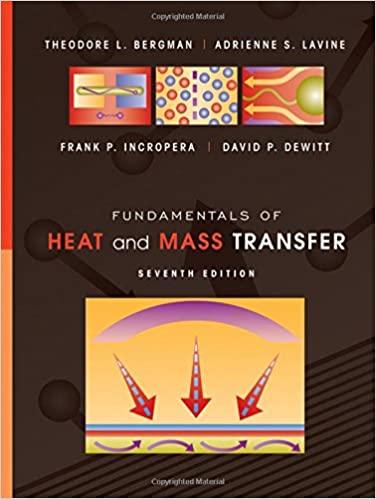To maintain pump power requirements per unit flow rate below an acceptable level, operation of the oil
Question:
To maintain pump power requirements per unit flow rate below an acceptable level, operation of the oil pipeline of Problem 8.63 is subject to the constraint that the oil exit temperature Tm,o exceed 110°C. For the values of Tm,i, Ts, D, ti, z, L, and ki prescribed in Problem 8.63, operating parameters that are variable and affect Tm,o are the thermal conductivity of the soil and the flow rate of the oil. Depending on soil composition and moisture and the demand for oil, representative variations are 0.25 ≤ ks ≤ 1.0 W/m · K and 250 ≤ mo ≤ 500 kg/s. Using the properties prescribed in Problem 8.63, determine the effect of the foregoing variations on Tm,o and the total heat rate q. What is the worst case operating condition? If necessary, what adjustments could be made to ensure that Tm,o ≥ 110°C for the worst case conditions?
Data From Problem 8.63
The problem of heat losses from a fluid moving through a buried pipeline has received considerable attention. Practical applications include the trans-Alaska pipeline, as well as power plant steam and water distribution lines. Consider a steel pipe of diameter D that is used to transport oil flowing at a rate mo through a cold region. The pipe is covered with a layer of insulation of thickness t and thermal conductivity ki and is buried in soil to a depth z (distance from the soil surface to the pipe centerline). Each section of pipe is of length L and extends between pumping stations in which the oil is heated to ensure low viscosity and hence low pump power requirements. The temperature of the oil entering the pipe from a pumping station and the temperature of the ground above the pipe are designated as Tm,i and Ts, respectively, and are known.
Consider conditions for which the oil (o) properties may be approximated as po = 900 kg/m3, cp,o = 2000 J/kg · K, vo = 8.5 X 10-4 m2/s, ko = 0.140 W/m · K, Pro =104; the oil flow rate is mo = 500 kg/s; and the pipe diameter is 1.2 m.
(a) Expressing your results in terms of D, L, z, t, mo, Tm,i, and Ts, as well as the appropriate oil (o), insulation (i), and soil (s) properties, obtain all the expressions needed to estimate the temperature Tm,o of the oil leaving the pipe.
(b) If Ts = 40°C, Tm,i = 120°C, t = 0.15 m, ki = 0.05 W/m · K, ks = 0.5 W/m · K, z = 3 m, and L = 100 km, what is the value of Tm,o? What is the total rate of heat transfer q from a section of the pipeline?
(c) The operations manager wants to know the tradeoff between the burial depth of the pipe and insulation thickness on the heat loss from the pipe. Develop a graphical representation of this design information.
Step by Step Answer:

Fundamentals Of Heat And Mass Transfer
ISBN: 9780470501979
7th Edition
Authors: Theodore L. Bergman, Adrienne S. Lavine, Frank P. Incropera, David P. DeWitt





